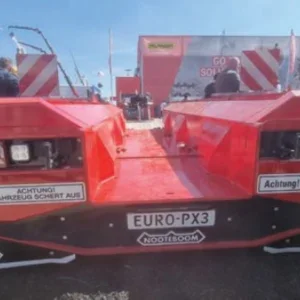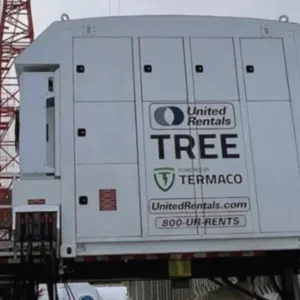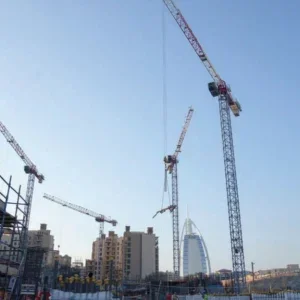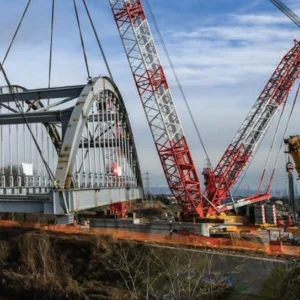Western Europe has long been considered the centre of demand for self erectors. These small to medium sized cranes, erected and operated using remote control, have been highly popular on the buildings sites of Italy, Spain, France and Germany. But Europe was particularly hard hit by the global recession, leading to oversupply of cranes, prices falling and machines sitting idle.
But the good news is that manufacturers and rental companies alike are now experiencing steady growth for self erectors. Demand has been remained strong in core markets like Germany, Switzerland, France and Austria but interestingly new markets such as the UK, Australia and the US are also opening their sites to the self erectors, even if for some it takes a little convincing.
One of the hardest hit markets was Italy. Stefano Nava, international sales manager at FB Gru, says, "Our company has been producing cranes for more than 55 years. We’ve mainly sold the self-erectors for residential building. Its been a tough market situation since 2009, but we’ve managed to keep selling our products.
"The Italian market was our main market. Now, the situation is not so good, so we decided to develop our international sales network. We started increasing our focus on exports in the past two years, but we’ve been selling overseas for more than 25 years.
"We’re mainly looking at European countries, with our best sales in France, Germany, Austria, Switzerland and Belgium. We’ve also sold cranes in Europe in the UK and Ireland, Netherlands, Spain, Poland, and the Czech Republic. More or less 70% of our sales are now exports.
"Our latest crane, shown at Bauma, was aimed at European markets like this. But we have also exported more traditional self-erecting cranes around the world, to markets in North Africa like, Algeria and Tunisia, and to Brazil, Australia and Antigua."
Breaking into new markets with these cranes can be a challenge, whether you’re bringing them to new countries, or customers unfamiliar with the technology. "It requires a major culture shift," says the sales director of a major UK-based crane supplier. "Companies are used to doing their work in a traditional way using telehandlers for example, but once they use self erectors they do like them," he says. "We get them out by letting them take it for the first job with a hefty discount. Then we charge standard rates after that and we do get a lot of repeat business," he says.
Another UK crane hire company, Bromsgrove’s Ladybird Crane Hire supplies a range of Manitowoc’s Potain self erectors. Such is its faith in the growing market Ladybird bought two new IGO 50s into the UK in February 2013 which were immediately sent off to work on residential and building projects in the Midlands and the South East.
"As a result of the recession, companies have focused on their core businesses and for some this has seen the disposal of poorly utilised cranes," says Robert Bird, managing director of Ladybird. "This has reduced the number of self-erecting cranes available in the country, and brought some balance back to the market. In addition to this we are seeing an increase in demand with developments taking shape around the country many of which are small scale residential sites that are perfect candidates for self-erecting cranes."
However, Bird says that he is cautious about a sustained rebound as the construction industry still remains depressed and remains a long way behind continental Europe when it comes to the acceptance of self erectors. Nevertheless the reduction in competition and steady growth has been good for the company. "Since a low point in 2009 we have seen almost four years of recovery. We are not back to the kind of levels that we saw in the period up to the summer of 2008 but we are getting there," says Bird.
The firm stocks a range of self-erectors. The smallest is the Igo 18 with a 1.8t capacity at 11.3m radius, which can lift 0.7t on the nose at a maximum radius of 24m. It also stocks the Igo 21,32,36 and the largest in the range is the Igo 50.
"Without a shadow of a doubt the most popular self erecting crane within our fleet is the Igo 50 which has a 40m maximum reach," says Bird. These machines can lift 4t at 14m radius and 1.1t at maximum reach. Hook height is 23.2m making them ideal for use on medium sized buildings. "They are used on care homes, schools and that sort of size building, 60-70 bed care homes are the most common" says Bird.
FB Gru are concentrating on compact design. Nava says, "We made many, many, contacts at Munich for the new crane. We are now building the first ten orders. The main feature of the new crane, the GX251, is its flexibility (can be erected in 42 different configurations) and the ability to erect it in very narrow spaces. It’s very compact, needing only 1.7m for rotation. But it can go high, and has a high capacity. It has a six-position jib (straight (full length, folded tip, half folded) and luffed (full length, folded tip, half folded)), allowing for a height under hook of 24m with the jib straight, and 35m when fully luffed. Its maximum capacity is 4t, and it can lift 1t on the jib end. With a luffing jib, it can lift 2t maximum. It can work with 220V current."
Manitowoc says that it has been working hard on developing its range. From the traditional Igo cranes that span the Igo 10 up to the Igo 50, there is now the larger T series which has an extendible mast allowing a greater height under hook. The T 70 A, T 85 A, and the T 130 offer a range of heights and capacities thanks to the flexibility of the lattice mast.
Manitowoc’s most recent new development is in its M series. These ultra mobile cranes are transported ready ballasted and can therefore be erected on site in less than 30 minutes. "The Igo M concept means mobility," explains Vincent Milan, senior product manager for self-erecting cranes at Manitowoc. "With a normal self erector you need half a day to erect. You have to set up, ballast, remove the axles and erect. With this crane you leave the axles on the crane and they are part of the ballast. The ballast is already in position to be used, so in less than half an hour you can be ready to lift your first load."
The most recent crane to be launched in this range is the Igo 14 M, which brings together and updates the features from the Igo MA 13 , MB 13 and MC 13 cranes. It can be configured for transportation at either 25kph or 80kph (bringing together features from the M 13 A and C), and it also has the adjustable radius of the MB 13. With a 19m hook height it also gives 3m more lift range than its predecessors. Milan says that a unique feature of this crane is that it has two positions for the counterweight, the short ballast radius of 2m allows to turn in the square footprint for more compact dimensions on site, and the other ballast radius of 2.5m provides the best lifting capabilities, (of 0.6t or 600Kg) out to its full radius of 22 m. "At 2.5m you have the best load curve in the market," says Milan.
For more compact dimensions on site, the counterweight can be set to a radius of 2m. In this narrower configuration, the Igo M 14 keeps good lifting capabilities with a maximum of 1.8 t and 500Kg at the full radius capacity at 22m . In both the short radius and full radius configurations the crane has an axle reaction below the 12t which is the road regulation limit for a crane. And in both configurations, the height under hook for the crane is 19 m, which Milan explains is more than its predecessors and more than any equivalent crane in this capacity class.
Milan says that other upgrades to the crane include the option of a fully remote hydraulic levelling system which is designed so that the sensitive part of the hydraulic cylinder is protected when in use. It has also been improved to make it more manoeuvrable thanks to a steering chassis which is also fully remote and therefore job site become more accessible. He envisages that the new M 14 will be popular in traditional markets of France and Germany and says that it could start to convince new markets. "The UK could be a good market for this crane. I am sure that there is a market for these in places like North America. But when the lift is just for a few days they are used to using truck mounted cranes or telehandlers. It is difficult to fight against habits. We need to spend time to convince and change the mentality but this is not so easy." He adds that the crisis has not been felt in this segment of the market thanks to the trend to sell these cranes to end users rather than rental companies.
An application that demonstrates this trend for end users to purchase the cranes, along with their growing international profile, is the use of a self erector, the Liebherr 81K, at the world famous America’s Cup World Series where the crane is used to lift the boats in and out of the water. The global event sees 11 AC45 wingsail catamarans compete in a series of races to win the opportunity to race for the America’s Cup against the previous year’s winner. The ACWS travels from venue to venue on a 525-foot cargo ship that carries 1,500 tons of gear, including boats, equipment and 110 containers that transform into a full-scale village directly on the pier for boat repair maintenance, operations, storage and hospitality. Setup and teardown each take approximately one week. "It only takes about two hours to set up or dismantle the crane and I can do it myself in most cases," says Graham Goff, the ACWS wing and platform logistics manager. "That’s short work for such key piece of equipment. When the boats are practicing and racing, we use the 81 K every day to get them into and out of the water. We couldn’t keep on schedule without the crane," he says explaining that each lift, in or out takes around 20 minutes.
The Liebherr fast-erect tower crane model first came to Goff’s attention when he was in New Zealand looking into renting a crane to lift the boats while on site. The high cost of mobile crane rental compared with the cost of a Liebherr 71K gave him the impetus to try out a tower crane. After placing boats for the ACWS with the 71K for a month, Goff was hooked and purchased the 81 K for use as the organization’s permanent crane. He needed a machine that could be certified to operate anywhere in the world using local power, whatever the voltage or frequency which the 81 K delivers, making access easy with a connection point located conveniently at the undercarriage. "We’ve traveled all over the world with the 81 K since purchasing it," says Goff. "In the 2011-2012 AC World Series, we’ve made several stops in the United States. The crane travels well by boat, road and rail."
The 81K is at the larger capacity end for self erectors with a maximum capacity of 6t (6000kg) or 1.4t (1400kg) on the nose, with a maximum radius of 45m. "It’s probably the most unusual application for a tower crane, but it was a viable option that enables us to contain our costs over the long run," comments Goff. "As someone involved in logistics, the efficiency we gain by using the 81K to get the boats in and out of the water is invaluable. We haven’t needed them yet, but parts and service are available all over the world."
Other firms too are convinced of the self erector’s efficiencies and benefits over other lifting options such as telehandlers or smaller top slewers. In January 2013, US tower crane specialists Morrow Equipment Company purchased a new 81K to meet growing demand in North America. "Companies in North America are more and more realising the benefits of a fast-erecting crane," explains Hans-Martin Frech, Liebherr Werk-Biberach marketing and market manager for tower cranes. "A fasterecting crane provides considerable benefits in terms of handling capacity for long term construction projects, as a result of their horizontal luffing."
North American based American Construction Equipment Company tells Cranes Today that it also appreciates the benefits of the self erectors and has been working to promote these to clients, however state regulations for Pennsylvania introduced by the unions over the past two-to-three years have made it more challenging.
"We used to be able to rent the customers and train one of their employees to operate the equipment but now the laws have changed and you have to have a certified operator for this so that is an added expense to an expensive piece of equipment and that is putting off some customers," explains rental operations manager Kevin Schaffer. "We used to have a lot of customers that used this but since the new laws came in they seem to be shying away from them." But he maintains that the cranes are still great on production. "Anyone that uses them, they love them, they love the production that they get, but it is a niche piece of equipment and we have to wait for those jobs to come. We do get plenty of calls," he says, having recently sold one to a contractor building assisted living homes.
Another market also reporting growth in demand for self erectors is Australia. Local rental firm Active Crane Hire says it is the country’s leading supplier of the cranes with around 40 units available for hire. Established in 2001 the company mainly stocks the Manitowoc Potain range.
"Recently we are seeing an increase in construction activity for self erecting cranes," says Hermann Buchberger, director at Active Crane Hire, but he says the adoption of the machines has been a slow process. "Although we have been involved in the market since 2001 it took quite a while to convince builders and contractors to try the concept of self erecting cranes," he says. "However whoever used the cranes gave a tremendous positive feedback, hence our business grew by repeat business and recommendations."
He explains that a big issue in Australia has always been the industrial pressure to use the same crane crew personnel as on tower cranes, which artificially increased the costs to operate the cranes. "Recently however builders and contractors are more open to the concept of employing their own crane operators which made the self erecting cranes become very competitive compared to mobile cranes and telehandlers," he says.
Meanwhile traditional markets are continuing to support this sector of the industry. Liebherr reports that its cranes are in demand from both small and large construction companies. "There is particularly high demand for the class from 60- 120t on the German, Austrian and Swiss markets," says Frech. "There is a clear trend in this respect to the effect that this powerful fast-erecting can replace small top-slewing cranes."
Terex agrees that demand has been strong in Germany and Switzerland "Particularly for road and bridge building. Italy and France have also had interesting activity in this," says associate marketing manager Agustin Dominguez. In mid-2012 the firm moved production of its self erectors from the historic home of Comedil in Fontanafredda, Italy, to Montceau-les-Mines, France. Dominguez says this has had a range of benefits. "We are closer to key markets, there are synergies with products that will make the value proposition of self erectors even more attractive to customers, and the move allowed the location in Fontanafredda Italy, to concentrate in its key area of expertise: flat top and luffing jib tower cranes," he says.
The firm points to a recent project in Sardinia where public works contractor Fabiani Costruzioni used six Terex CBR 36 H self-erecting cranes on line 3 of the Calgliari metro system. The work involves placing an 1,800m viaduct using pre-cast posttensioned structures. The ground level job site was only between 3 and 5m wider than the deck above. "Given the on site logistic challenges, we decided to use six self erecting cranes, like this we cover a large area but with a very small footprint that allows the work to continue at ground level," explains Fausto Poli, engineer at Fabiani. "We decided to use Terex because for the past ten years, we’ve used three types of Terex cranes of varying size (self-erecting, tower, and Flat Top) and have appreciated their reliability, the availability of spare parts and the support we get," he says.
Terex too has been developing its self erectors, launching its largest, the 6t capacity EaZy 90, at Intermat France in April 2012. The versatile machine offers 15 under-hook heights ranging from 1.45m to 46m, and it can maintain its 6t capacity at up to 13.5m radius using the standard 45m jib, up to 14.3m using its 37.5m short jib; and up to 15.26m in 30m folded jib configuration. Its maximum 1.4t jib tip capacity can be raised to 1.45t when equipped with two pull lines. Operational flexibility is further increased by a choice of three different jib angle settings from horizontal, to 10° and 25°.
As the products continue to evolve and improve, offering more benefits than previous models, clients are realizing the potential production savings that can be had from self erectors. Most firms report that they are "cautiously optimistic" about the future for this segment especially with demand recovering in traditional markets and new country’s appreciating the machines.
"Customers are starting to learn the fact that even with low labour costs, self erectors bring benefits to jobsites," says Dominguez. "As labour costs increase, the benefits will be even greater."






